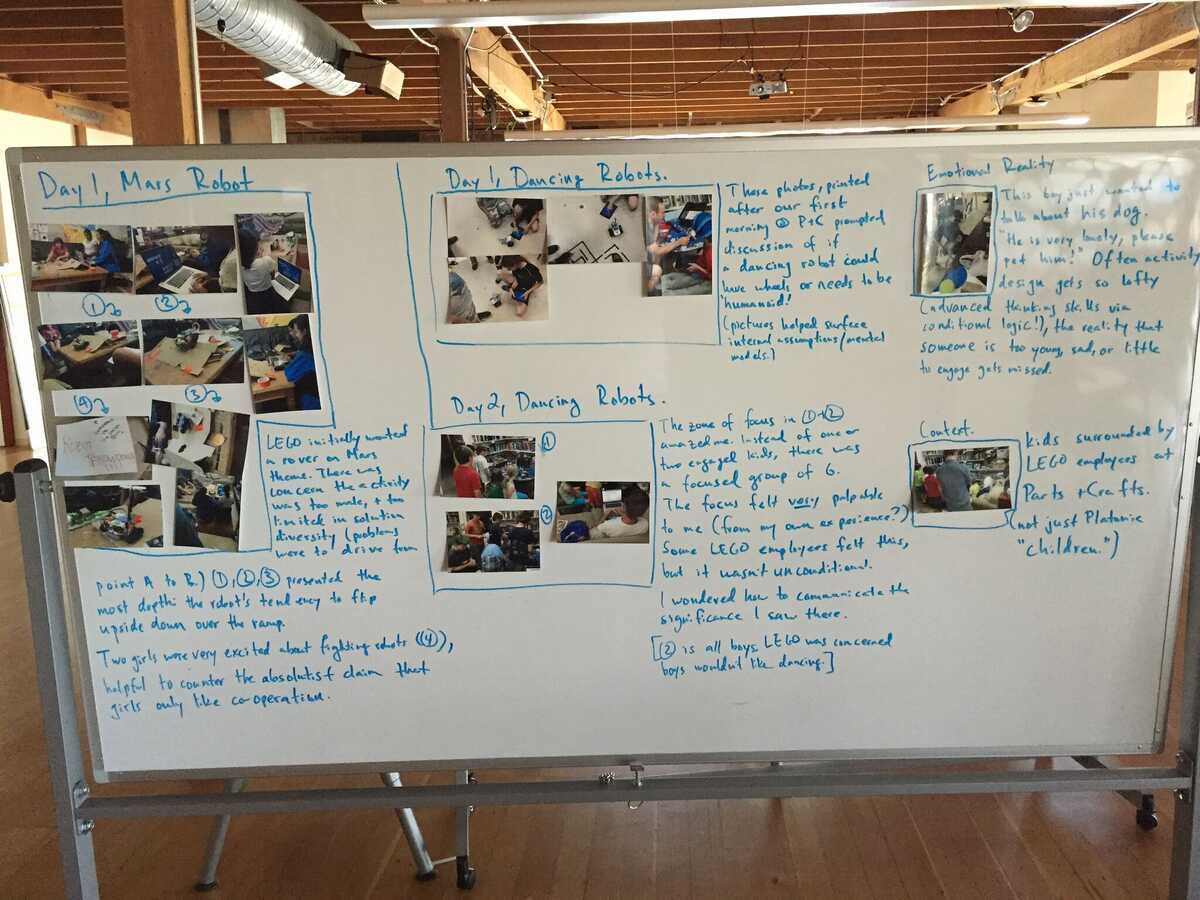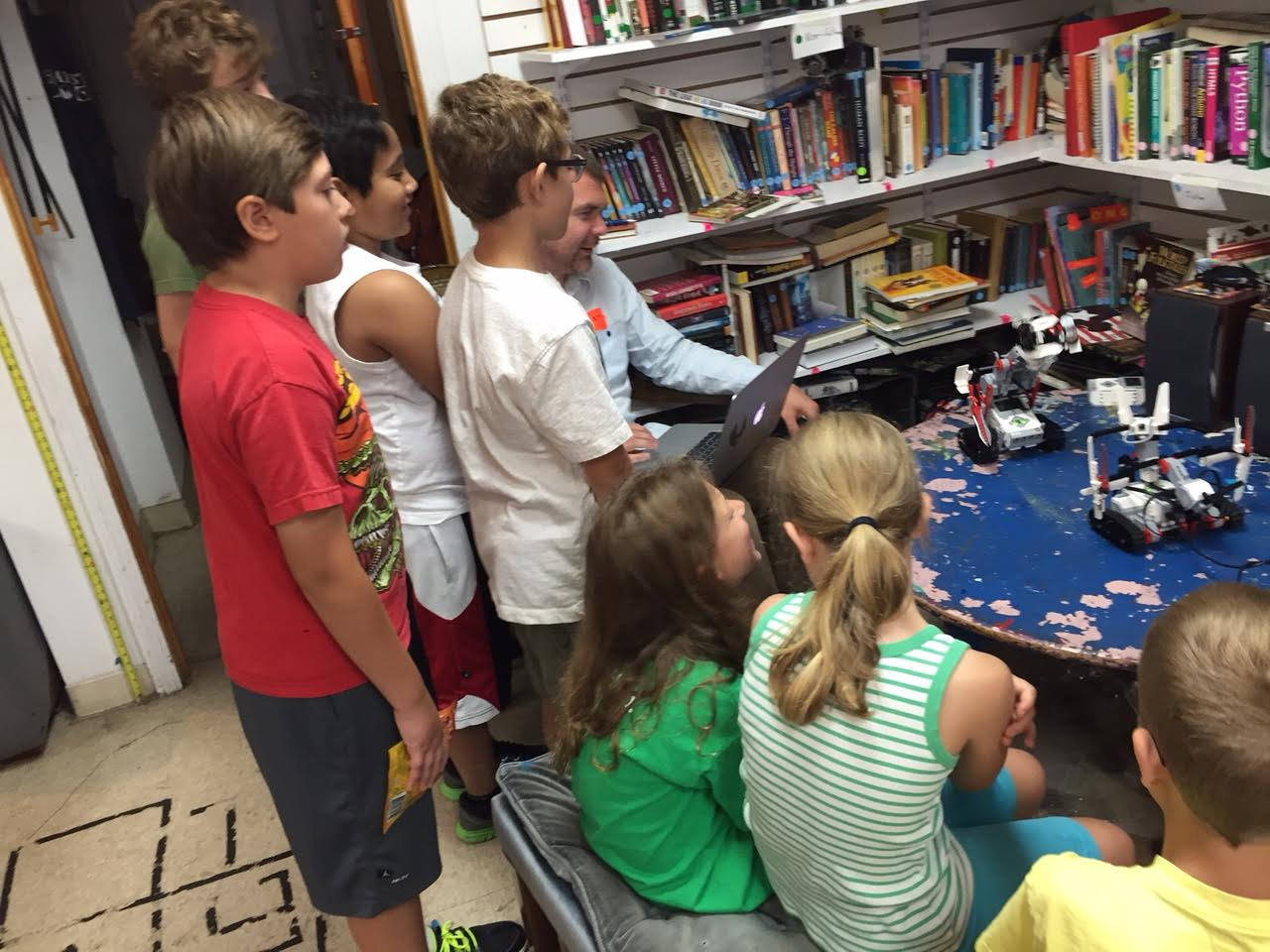I went to the first day of this workshop and it was fun! I was primarily with two girls that were programming a mars rover (that the lego people had put together?) to go over a cardboard course.
Something that struck me about the two girls trying to program the robot in a scratch-like way (putting digital directional blocks together, like forward, left, right, punch, etc) was how bad they were at it. They were staring almost entirely at the computer and not reasoning about the physical obstacles the robot had to overcome. They would make plans but not really verify them in reality. They would barely look at the course and definitely didn't try to play-act with the robot what it should do before programming it. I'm not exactly sure what was going on here. My first guess was that the tools were so stuck in the screen that they couldn't make the connection between their scripts and reality. But my second guess is that maybe they didn't really care about being "right" and successfully navigating the course, but rather it was kind of fun to tweak the program and be surprised about the wacky behavior the robot had. Their actions told me my second guess was right, but how they vocalized it made me think that they actually cared a little about the robot's success. Weird!
On Wed, Aug 19, 2015 at 3:57 PM, Michael Nagle wrote:
Hello email list.So, I have a lot of thoughts about the LEGO workshop I helped run last week. I will try to nail some down here and then see where this goes. There a bunch of photos with some commentary from me up on a whiteboard over in whiteboardland.The upper right part, with glare, says: "Emotional Reality. This boy just wanted to talk about his dog. 'He is very lonely, please pet him!' Often activity design gets so lofty (advanced thinking skills via conditional logic!), the reality that someone is too young, sad, or little to engage gets missed.-----
So the workshop was a 3-day thing, hosted at a robotics & education lab in Tufts. The team from LEGO is desiging for a new interactive museum they are opening in 2017 in Denmark. I was brought on because of one of the team members was concerned that the activities being designed were too limited in terms of possible solutions, and they wanted help bringing in a constructionist perspective.In developing the workshop, I pushed for as much time with children in trying out and developing activities as possible. This wish was granted, and we spent the morning of the 2nd and 3rd workshop and Parts and Crafts, trying stuff out. The rest of the time the team was at Tufts, actively discussing what activity they wanted to design for their museum.-----There were a couple of big themes in my mind, in trying to understand how I could be useful to this theme:1. Stay as close as possible to real experience. I assume that most people's mental models of how children learn are deeply flawed. I also assume that for the most part, mere language alone does not have the requisite emotional power to actually get people to reconsider core beliefs and shift their worldview. So the starting point was seeding the workshop with actual experience. But then the follow up questions were:* how can I point out what I see as valuable in the P&C workshops? Either during them, or afterwards, and relatedly* can media of the P&C workshops be used to anchor the ongoing conversation in the actual experience, instead back into the land of faulty mental models and the associated defensiveness?2. Change comes when a team can clearly see the whole system of tensions it is operating under. This is basically my digestion of Robert Kegan's work in _Immunity to Change_ and _How the Way We Talk Can Change The Way We Work_. So my job, as someone who holds the belief that the constructionist perspective is a more nuanced view on learning than the more common notion of streamlining learning (making learning perhaps 'faster' or 'more efficient' but still sticking to a core right/wrong model of learning) was to try and actively surface tensions and somehow name them, make them known, and try to support individuals in finding language to make what they felt more tangible and known to the group. Trying to actively facilitate a shift from 'efficient learning' to constructionism, while acknowledging that change seems to happen only when an individual can fully see the systems of tensions in their belief system.Constructing constructionism is what I shorthanded this as internally.-----I got a Selphy photo printer at Rob's suggestion. The idea was to take photos at the P&C workshops, print them out right after, and use them for discussion. This seemed ... good. But not amazing. It certainly worked in that if you hand someone a stack of photos, they flip through them (which seems to me unlike the offer of digital photos), and the discussion instantly changed on doing this. But I really wanted a kind of durable, accretion-model. Like, the group was actively building up an understanding of:* constraints in the museum (20 minutes long in on-peak season, 18 - 36 kids, etc.)* values held by the lego group (solution diversity, relevant narrative, lighthearted tone, approachable to boys and girls)* possible activities that seemed appealing to them (initially a mars rover explorer, and then robots that danced)Some of these were obvious initially, and some of them were emerging insights coming either from within the group, or from my or the robotics' students contributions (i.e. the value of narrative.) This understanding seemed to sharpen and clarify over the 3 days.from Day 2, 1st P&C Workshop. After I printed out this photo of a boy making this robot dance, the LEGO team discussed if a dancing robot should have wheels or not. It was interesting to see the image surface the assumption from some team members than dancing robot means humanoid robot.The photo intervention felt like a good starting point, but it ended up feeling like a one-shot intervention. The photos came, sparked new questions, the conversation went in that direction, but it didn't endure. I found myself feeling like the only way out of the rabbit hole of confusion was to stay close to real experience as possible.Sometimes I saw things that I didn't know how to point out.from Day 3, 2nd P&C workshop. The LEGO team decided to focus on dancing robots, and ran a few 'rounds' simulating the 20 minute constraint. Both times, the groups of children quickly cohered and focused on the activity at hand. This made an impression on me. Children's attention and engagement has a very palpable, almost physical quality for me. How could you help make that visible to someone else? I found myself calling this phenomenon a 'zone of focus.'This was a scene I wondered about a lot. Some of the LEGO designers saw this activity run and were excited. Some weren't sure. I found myself trying to better understand how it was that I perceived this part of the workshop as much more engaged than the first one (I understand why I likely value this more than the LEGO team -- for me authentic engagement is the springboard into depth.) How could I make what I saw visible?---Alright. Last part for this email.So one step would have been to have the print-outs persist in a single place. We were moving between rooms at Tufts, but it would have been good to make the photos of the workshops persistent -- so that they could ambiently inform the conversation, instead of being more like a one-shot intervention.But then video? What does it mean to fluidly bring that into a conversational space?I took a time-lapse video, as provided by iOS 8's camera app, of the last workshop. I thought this would be revealing. It was surprising to me how not useful this timelapse video seemed. Was this a property of my angle (not being able to see the robot clearly enough?), frequency of pictures being taken, or just timelapse maybe being not quite right for this? (timelapse: https://www.dropbox.com/home/Photos?preview=Video+Aug+13%2C+7+44+33+AM.mov )I took a few videos. One was very revealing, I think of this 'zone of focus' pattern shows up better in a video. You can also see a boy dancing as a way to tell the LEGO employee what he wants the program to do (for example, at 0:14), which evoked Papert's notion of body syntonicity in a neat way. It seems great to have ways into enacting or embodying complex thoughts without being dependent on comprehension of a syntax or grammar to that end. (video: https://www.dropbox.com/s/f1vhfxde4rq0lur/Video%20Aug%2013%2C%207%2052%2045%20AM.mov?dl=0 )So there's a question here of how to bring these pieces into the discussion. A friend of mine showed me a consultant's tool -- which was basically hang up a piece of fabric, spray it with spray adhesive, and then cover it with index cards, photos, post-its, whatever. A giant, sticky, rearrangable wall that can go up anywhere. So maybe if that's dynamic you can easily start posting up videos, and then doing things like expanding them out into frame-based timelines, highlighting certain spots, ... ?---That's it. I have many more thoughts about this workshop, but this already feels like a massive email. I am happy to share more thoughts. Zoomed out, I wonder if there's a throughline somewhere from Kegan's Immunity to Change work to Engelbart's augmentation work, specifically in the context of facilitating teams who are interested in designing for or in the direction of constructionism.All thoughts welcome. Thanks if you made this far!


